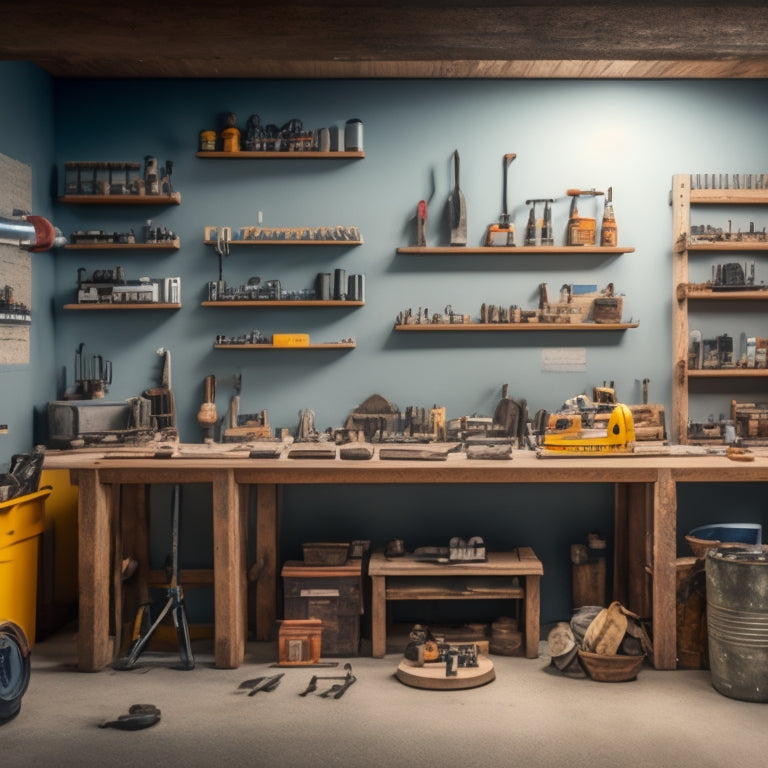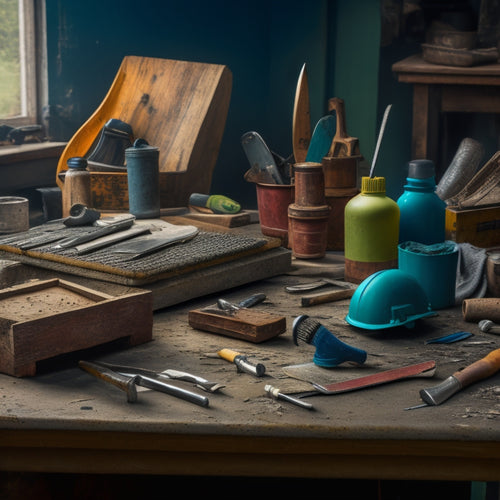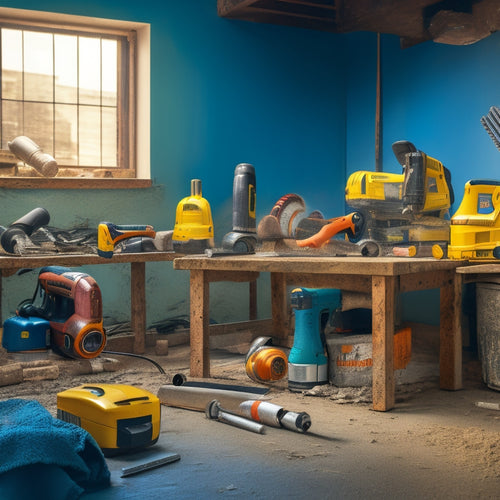
Best Tools for Concrete Wall Finishing Success
Share
To achieve a flawless concrete wall finish, you'll need to assemble a well-rounded toolkit that includes power trowels for smooth finishes, edgers for clean lines and corners, floats for leveling concrete surfaces, and tamping tools for solid foundations. Grinding and polishing machines are also essential for high-gloss finishes, while concrete scarifiers prepare the surface for treatments. Finishing trowels allow for precise texture control. With so many specialized tools involved, it's vital to understand the specific roles each plays and how to optimize their performance. Now, discover how to choose the right tools for your project and reveal a showroom-worthy finish.
Key Takeaways
• Power trowels are essential for achieving smooth, even finishes on concrete walls, with regular maintenance and proper lubrication crucial for tool longevity.
• Grinding and polishing machines are vital for high-gloss finishes, with surface preparation and polishing compound selection critical for optimal results.
• Edgers are necessary for creating sharp, clean lines and corners, with precision-control capabilities and edge sealing techniques ensuring durable, long-lasting surfaces.
• Finishing trowels enable precise control over final concrete texture, with selection of trowel size, shape, and material impacting comfort and effectiveness.
• Surface preparation and leveling tools, such as floats and tamping tools, are critical for leveling concrete surfaces and creating a solid foundation for wall finishing.
Power Trowels for Smooth Finishes
You'll rely on power trowels to achieve a smooth, even finish on your concrete walls, as these versatile tools can efficiently spread and flatten freshly poured concrete with precision and control.
When selecting a power trowel, you'll have several types to choose from, including walk-behind, ride-on, and edger models. Each type is designed for specific applications, so it's important to choose the right one for your project.
Proper trowel maintenance is vital to guarantee peak performance and extend the tool's lifespan. Regularly inspect the trowel's blades for wear and tear, and replace them as needed.
Clean the trowel thoroughly after each use, paying attention to the gearbox and bearings. Lubricate the moving parts regularly, and store the trowel in a dry, protected area.
Edgers for Clean Lines and Corners
When you're working on concrete wall finishing, you know how essential it's to achieve sharp, clean lines and corners.
That's where edgers come in - these specialized tools help you maintain corner edge control, creating crisp, 90-degree angles that make all the difference in a professional-looking finish.
Corner Edge Control
Achieving crisp, clean lines and corners on concrete walls requires employing specialized tools, specifically corner edge control edgers, to effectively manage and shape the concrete's edge profile.
These edgers are designed to precision-control the concrete's flow, allowing you to create sharp, defined corners and edges. By using corner edge control edgers, you can implement corner protection strategies that prevent damage and guarantee a smooth, even finish.
When working with concrete, it's crucial to employ edge sealing techniques to prevent water infiltration and subsequent damage.
Corner edge control edgers enable you to create a secure, watertight seal, reducing the risk of cracks and deterioration. With these tools, you can achieve a high-quality finish that meets your exacting standards.
By precision-controlling the concrete's edge profile, you can create a durable, long-lasting surface that withstands the test of time.
With the right corner edge control edgers, you'll be able to achieve professional-grade results that exceed your clients' expectations.
Clean Line Creation
To create clean lines and corners on concrete walls, edgers with specialized profiles are vital for cutting and shaping the concrete to precise angles and radii. You need tools that can help you achieve accurate line marking and edge alignment. This is where edgers with unique profiles come into play.
Here are some key features to look for in edgers for clean line creation:
-
Radius control: Edgers with adjustable radius control allow you to achieve precise curves and arcs.
-
Edge alignment guides: Guides that help you maintain straight lines and accurate edge alignment are essential for achieving clean lines.
-
Profile customization: Edgers that allow for customizable profiles enable you to create unique shapes and designs.
- Adjustable cutting depth: Being able to adjust the cutting depth guarantees you can work with varying concrete thicknesses.
Smooth Edge Finishing
You'll need edgers that can refine your clean lines and corners, creating a smooth, polished finish that showcases the precision of your concrete wall finishing skills.
To achieve this, you'll require edgers that can precision-cut and smooth out edges with ease. Look for edgers with adjustable handles and precision-ground blades that allow for precise control over the smoothing process.
When selecting an edger, consider the type of concrete you're working with and the desired edge aesthetics. For example, if you're working with a high-gloss finish, you'll want an edger that can produce a razor-sharp edge with minimal imperfections.
Additionally, consider the smoothing techniques you'll employ, such as using a wet or dry method, and choose an edger that accommodates your preferred approach.
Floats for Leveling Concrete Surfaces
As you begin finishing a concrete wall, using a float to level the surface becomes a critical step in achieving a smooth, even finish. A float is a tool that helps to remove excess concrete, fill in low spots, and create a uniform surface.
When choosing a float, consider the following factors:
-
Float materials: Select a float made from high-quality materials, such as magnesium or aluminum, which provide a smooth finish and are durable enough to withstand heavy use.
-
Float techniques: Master various float techniques, including pushing, pulling, and feathering, to achieve the desired finish.
-
Float size and shape: Choose a float that fits comfortably in your hand and has a shape that allows you to easily reach into corners and edges.
- Float maintenance: Regularly clean and maintain your float to prevent concrete buildup and guarantee peak performance.
Tamping Tools for Solid Foundations
When you're working on a concrete wall, you'll need to use tamping tools to create a solid foundation.
You'll want to focus on two critical points: leveling the surface to guarantee it's even and compacting the mix to remove air pockets and excess water.
Leveling the Surface
To guarantee a solid foundation, start by leveling the surface of your concrete wall using tamping tools, which compact and flatten the material to create an even base. This vital step in surface preparation secures that your concrete wall finishing project gets off to a strong start.
When it comes to leveling techniques, you'll want to focus on achieving a uniform surface. Here are some key considerations to keep in mind:
-
Remove excess material: Use a tamping tool to remove any excess concrete that's risen above the desired level.
-
Check for dips and humps: Identify any dips or humps in the surface and address them promptly to prevent unevenness.
-
Use a spirit level: Verify that the surface is level using a spirit level, making adjustments as needed.
- Compact the edges: Pay special attention to the edges of the wall, where material can often become loose or uneven.
Compacting the Mix
You'll need to employ a range of tamping tools to compact the mix and create a solid foundation for your concrete wall finishing project. Compacting the mix is essential to achieving the desired mix consistency, ensuring a stable and durable concrete structure.
Hand tampers, plate compactors, and jumping jacks are vital tools for compacting the mix. Hand tampers are ideal for smaller areas, while plate compactors and jumping jacks are better suited for larger surfaces. These tools help remove air pockets, ensuring a dense and stable concrete foundation.
Moisture control is also important during the compaction process. Excessive moisture can lead to weak and brittle concrete, while insufficient moisture can result in a porous and unstable structure.
Grinding and Polishing Machines
Grinding and polishing machines are crucial for achieving a high-gloss finish on concrete walls, as they effectively remove surface imperfections and prepare the surface for further finishing treatments. When selecting a grinding and polishing machine, you'll want to evaluate the specific requirements of your project.
Here are a few key factors to keep in mind:
-
Grinding techniques: Will you be using wet or dry grinding methods? Each has its own advantages and disadvantages, and the right technique for your project will depend on the specific concrete and finish you're aiming for.
-
Polishing compounds: What type of polishing compounds will you be using? Different compounds are designed for specific types of concrete and finishes, so it's important to choose the right one for your project.
-
Machine weight and size: Will you be working in a small, confined space or on a large, open area? The size and weight of your machine will impact its maneuverability and ease of use.
- Power and speed: How much power and speed do you need to efficiently grind and polish your concrete surface?
Concrete Scarifiers for Surface Prep
Concrete scarifiers are essential tools for surface preparation, capable of removing thin layers of concrete, old coatings, and other unwanted substances to create a clean, textured surface for finishing treatments.
When you're working on a concrete wall finishing project, a scarifier is a must-have tool in your arsenal. It helps you achieve a surface that's ready for coatings, overlays, or other finishes.
To get the most out of your scarifier, you need to prioritize scarifier maintenance. Regularly inspect and replace worn-out cutting drums, and keep the machine clean to prevent dust buildup. This will guarantee peak performance and extend the lifespan of your equipment.
When it comes to surface preparation, a scarifier is unmatched in its ability to remove imperfections and create a textured surface. By adjusting the drum speed and angle, you can control the level of aggression and texture desired.
This versatility makes scarifiers an indispensable tool for achieving a smooth, even finish. With proper maintenance and operation, a scarifier will help you achieve a surface that's ready for the final finishing touches.
Finishing Trowels for Texture Control
With a surface prepped and textured by a scarifier, you can now switch to a finishing trowel to refine the texture and achieve a high-quality, uniform finish. This is where you have precise control over the final appearance of your concrete wall.
Finishing trowels are designed to manipulate the concrete to achieve specific textured finishes, and mastering their use is essential for successful concrete wall finishing.
Here are some key considerations when selecting a finishing trowel for texture control:
-
Trowel size and shape: Choose a trowel that fits comfortably in your hand and is suitable for the size of your project.
-
Blade material and flexibility: Select a trowel with a blade that's durable, yet flexible enough to conform to the surface.
-
Handle ergonomics: Opt for a trowel with a comfortable, ergonomic handle that reduces fatigue.
- Finishing techniques: Familiarize yourself with various finishing techniques, such as swooping, feathering, and edging, to achieve the desired textured finish.
Frequently Asked Questions
What Safety Gear Is Essential for Concrete Wall Finishing Projects?
When you're working on concrete wall finishing projects, you're exposing yourself to hazardous materials and rough surfaces.
You must wear essential safety gear to protect yourself from harm. Invest in high-quality protective equipment like dust masks, safety glasses, and gloves to prevent respiratory issues, eye injuries, and skin abrasions.
Don't compromise on your well-being - make sure you're adequately equipped to tackle the job with confidence and control.
Can I Use the Same Tools for Finishing Interior and Exterior Walls?
As you step onto the job site, the concrete wall stares back at you like a blank canvas.
You're about to bring it to life with a flawless finish.
Now, you're wondering: can you use the same tools for interior and exterior finishing?
The answer is, it depends.
While some tools, like trowels and floats, can be used for both, others, like sealants and coatings, are specific to interior or exterior finishing.
You'll need to adjust your toolkit to guarantee the right finish for each environment.
How Do I Maintain and Clean My Concrete Finishing Tools?
You're investing time and money into your concrete finishing tools, so it's crucial to maintain and clean them properly.
For tool storage, designate a dry area with minimal exposure to the elements.
Regularly inspect your tools for damage or wear, and perform maintenance tasks like lubricating moving parts and sharpening blades.
Follow these maintenance tips to extend the lifespan of your tools and guarantee peak performance on your next project.
Are There Any Specific Tools for Working With Colored or Stamped Concrete?
When working with colored or stamped concrete, you'll need specialized tools to achieve ideal results.
For color application techniques, you'll require a color hardener applicator or a spray system to evenly distribute the color.
For stamping methods, invest in a set of high-quality stamping tools, such as texture mats and stamping rollers, designed for specific patterns.
These tools will help you achieve precise control over the final design and color of your concrete project.
Can I Rent Concrete Finishing Tools Instead of Buying Them?
You're considering renting concrete finishing tools instead of buying them, and that's a smart move.
Tool rental benefits include reduced upfront costs and access to specialized equipment without long-term commitment.
Compare the cost of renting versus buying, and you'll likely find rental options are more cost-effective, especially for infrequent or one-time projects.
Conclusion
Now that you've got the best tools for concrete wall finishing success, it's time to put them to work.
But don't think you're done yet - the real challenge lies in mastering the techniques to get the most out of these tools.
Stay tuned for the next chapter in your concrete finishing journey, where the secrets to achieving flawless, high-gloss finishes will be revealed.
The floor is yours - are you ready to take it to the next level?
Related Posts
-

Must-Have Handheld Tools for Concrete Repair
When tackling a concrete repair project, it is crucial to have the right handheld tools to achieve a professional fin...
-

Essential Power Tools for Concrete Block Construction
When building with concrete blocks, you'll need a range of power tools to cut, drill, mix, and finish the blocks to g...
-

Why These Concrete Tools Are Always in Demand
You rely on a set of trusted concrete tools to deliver high-quality results, and it's not surprising - these tools ar...


